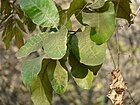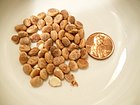Note: This is a project under development. The articles on this wiki are just being initiated and broadly incomplete. You can Help creating new pages.
Difference between revisions of "Buchanania cochinchinensis - Priyala"
(→Chemical Composition) |
(→References) |
||
| Line 82: | Line 82: | ||
<references> | <references> | ||
<ref name="Uses">[https://easyayurveda.com/2015/09/03/chironji-buchanania-lanzan-uses-dose-side-effects/ Uses]</ref> | <ref name="Uses">[https://easyayurveda.com/2015/09/03/chironji-buchanania-lanzan-uses-dose-side-effects/ Uses]</ref> | ||
| + | <ref name="Chemical composition">[http://gbpihedenvis.nic.in/PDFs/Glossary_Medicinal_Plants_Springer.pdf Chemical composition]</ref> | ||
<ref name="Leaf">[http://keralaplants.in/ BOTANIC DESCRIPTION]</ref> | <ref name="Leaf">[http://keralaplants.in/ BOTANIC DESCRIPTION]</ref> | ||
Revision as of 12:43, 24 June 2019
Priyala, is a moderate sized tree of the dry forests of peninsular India, whose fruits and kernels are much valued as food. The fruits have a sweet and sour taste and the kernels, called chironji have a rich almond like flavour, which are also used in making sweets.
Contents
- 1 Uses
- 2 Parts Used
- 3 Chemical Composition
- 4 Common names
- 5 Properties
- 6 Habit
- 7 Identification
- 8 List of Ayurvedic medicine in which the herb is used
- 9 Where to get the saplings
- 10 Mode of Propagation
- 11 How to plant/cultivate
- 12 Commonly seen growing in areas
- 13 Photo Gallery
- 14 References
- 15 External Links
Uses
Gastritis, Burning sensation, Fever, Aphrodisiac, Excessive thirst. [1]
Parts Used
Chemical Composition
The oil is a promising source of palmitic and oleic acids. Kernel lipids (65.6%), comprised mainly of neutral lipids (90.4%), consist mostly of triacylglycerol (82.2%), freefatty acids (7.8%) and small amount of diacylglycerols, monoacylglycerols and sterols. [2]
Common names
| Language | Common name |
|---|---|
| Kannada | murkalu, kolemaavu |
| Hindi | char, charoli, chironji, |
| Malayalam | cheru, kalamavu, moongapezhu, mungaperlu, munnalperu |
| Tamil | cara paruppu, kattu-ma, saraiparuppu |
| Telugu | chaara, charumaamidi, chinna morli, sarapappu |
| Marathi | NA |
| Gujarathi | NA |
| Punjabi | NA |
| Kashmiri | NA |
| Sanskrit | kharaskandha, rajadana, bahulavalkala, priyala, chara |
| English | Cudappah almond |
Properties
Reference: Dravya - Substance, Rasa - Taste, Guna - Qualities, Veerya - Potency, Vipaka - Post-digesion effect, Karma - Pharmacological activity, Prabhava - Therepeutics.
Dravya
Rasa
Madhura (Sweet)
Guna
Snigdha (Oily), Guru (Heavy)
Veerya
Sheeta (cold)
Vipaka
Karma
Pitta, vata
Prabhava
Habit
Identification
Leaf
| Kind | Shape | Feature |
|---|---|---|
| Simple | alternate | petiole 12-22 mm, stout, glabrous; lamina 10-23.5 x 5-12 cm, broadly oblong, base round or acute, apex obtuse or emarginate, margin entire, glabrous above and densely tomentose beneath, coriaceous; lateral nerves 10-20 pairs, pinnate, prominent, pubescent, secondary laterals prominent, intercostae reticulate, prominent. |
Flower
| Type | Size | Color and composition | Stamen | More information |
|---|---|---|---|---|
| Bisexual | Terminal and axillary panicles | Greenish white | 5 | calyx lobes 5, persistent; petals 5, oblong, reflexed, pilose; stamens 10, inserted at the base of fleshy disc; filaments free, glabrous; disc cupular, 5 lobed, pilose; carpels 5-6, free, superior, tomentose, 4 reduced to thread like processes, one fertile, ovule one, pendulous; style lateral; stigma truncate. |
Fruit
| Type | Size | Mass | Appearance | Seeds | More information |
|---|---|---|---|---|---|
| A drupe | 10-13 x 8 mm | oblong, laterally compressed, black; stone hard, 2 valved; seed one. | {{{6}}} |
Other features
List of Ayurvedic medicine in which the herb is used
Where to get the saplings
Mode of Propagation
How to plant/cultivate
Season to grow
Soil type
Propagation
Commonly seen growing in areas
Photo Gallery
References
External Links
- Ayurvedic Herbs known to be helpful to treat Gastritis
- Ayurvedic Herbs known to be helpful to treat Burning sensation
- Ayurvedic Herbs known to be helpful to treat Fever
- Ayurvedic Herbs known to be helpful to treat Aphrodisiac
- Ayurvedic Herbs known to be helpful to treat Excessive thirst
- Herbs with Fruits used in medicine
- Herbs with Seed kernel used in medicine
- Herbs with Bark used in medicine
- Herbs with common name in Kannada
- Herbs with common name in Hindi
- Herbs with common name in Malayalam
- Herbs with common name in Tamil
- Herbs with common name in Telugu
- Herbs with common name in Sanskrit
- Herbs with common name in English
- Habit - Tree
- Index of Plants which can be propagated by Seeds
- Herbs that are commonly seen in the region of Tropical area
- Herbs
- Deccan
- Tree
- Anacardiaceae






